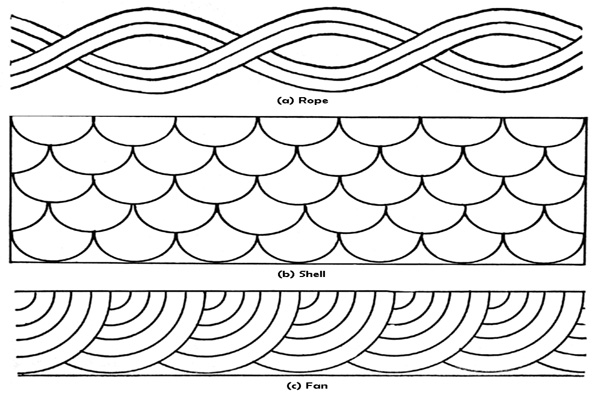Quilting
Quilting Frame
In earlier days the quilting frame could be found in every home, its simple construction making this possible. In its usual form it consists of four narrow pieces of wood, two somewhat longer than a quilt, and two shorter, perhaps half as long, with holes bored in the ends of each piece. These pieces are made into an oblong frame by fastenings of bolts or pegs, and are commonly supported on the backs of chairs. More pretentious frames are made with round pieces for the sides, and with ends made to stand upon the floor, about the height of a table, these ends having round holes into which the side pieces fit. Such a frame is then self-supporting and frequently has a cogwheel attachment to keep the sides in place and to facilitate the rolling and unrolling of the quilt. The majority of frames are very plain, but occasionally a diligent quilter is encountered who has one made to suit her particular requirements, or has received an unusually well-built one as a gift.
One old frame worthy of mention was made of cherry with elaborate scroll designed ends, cherry side bars, and a set of cogwheels also made of cherry; all finished and polished like a choice piece of furniture.
Each side bar or roll of the quilting frame is tightly wound with cotton strips or has a piece of muslin firmly fastened to its entire length, to which is sewed the edges of the lining, one side to each bar. Then the extra length is rolled up on one side of the frame, and after being tightly stretched, the wooden pieces are securely fastened. On this stretched lining or back of the quilt, the cotton or wool used for filling or interlining is spread very carefully and smoothly; then with even greater care the top is put in place, its edge pinned or basted to the edge of the lining, and drawn tightly over the cotton. The ends of the quilt must also be stretched. This is done by pinning pieces of muslin to the quilt and wrapping them around the ends of the frame. Great care is required to keep all edges true and to stretch all parts of the quilt uniformly.
Upon this smooth top the quilting is drawn, for even the most expert quilters require outlines to quilt by. If the quilt top is light in colour the design is drawn with faint pencil lines; if the colours are too dark to show pencil markings, then with a chalked line. It is a fascinating thing to children to watch the marking of a quilt with the chalk lines. The firm cord used for this is drawn repeatedly across a piece of chalk or through powdered starch until well coated, then held near the quilt, and very tightly stretched, while a second person draws it up and lets it fly back with a snap, thus making a straight white line. How closely the lines are drawn depends wholly upon the ambition and diligence of the quilter. The lines may be barely a quarter of an inch apart, or may be placed only close enough together to perform their function of keeping the interlining in place.
Patterns of quiltings are not as plentiful as designs for the patchwork tops of quilts; only about eight or ten standard patterns being in general use. The simplest pattern consists of “single diagonal” lines, spaced to suit the work in hand. The lines are run diagonally across the quilt instead of parallel with the weave, in order that they may show to better advantage, and also because the cloth is less apt to tear or pull apart than if the quilting lines are run in the same direction as the threads of the fabric. The elaboration of the “single” diagonal into sets of two or more parallel lines, thus forming the “double” and “triple” diagonals, is the first step toward ornamentation in quilting. A further advance is made when the quilting lines are crossed, by means of which patterns like the “square,” “diamond,” and “hanging diamond” are produced.
Wavy lines and various arrangements of hoops, circles, and segments of circles are among the more complex quilting patterns, which are not particularly difficult. Plates and saucers of various diameters are always available to serve as markers in laying out such designs. The "pineapple," "broken plaid," and "shell" patterns are very popular, especially with those who are more experienced in the art. One very effective design used by many quilters is known as the "Ostrich Feather." These so-called feathers are arranged in straight bands, waved lines, or circles, and—when the work is well done—are very beautiful. The "fan" and "twisted rope" patterns are familiar to the older quilters but are not much used at the present time.
Traditional Quilting and Beyond...



